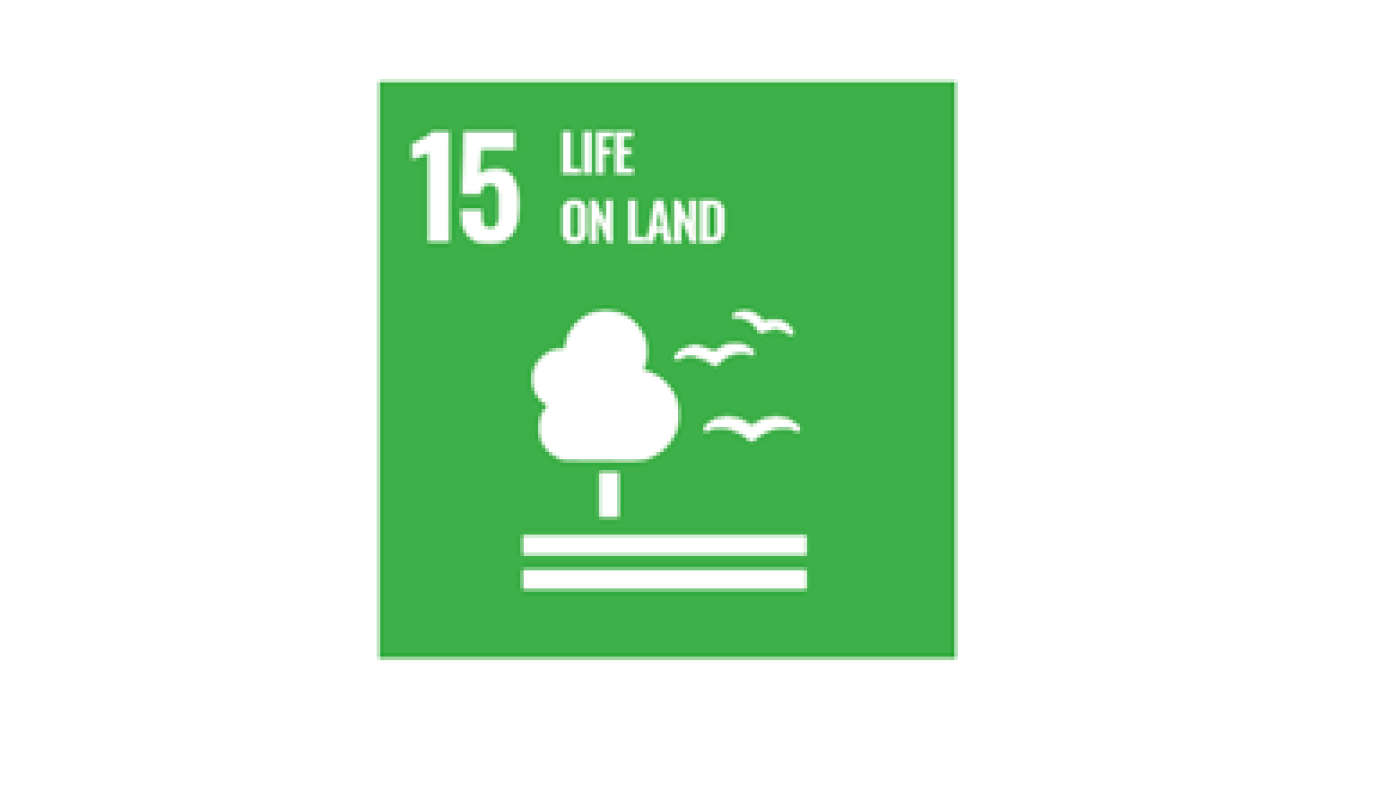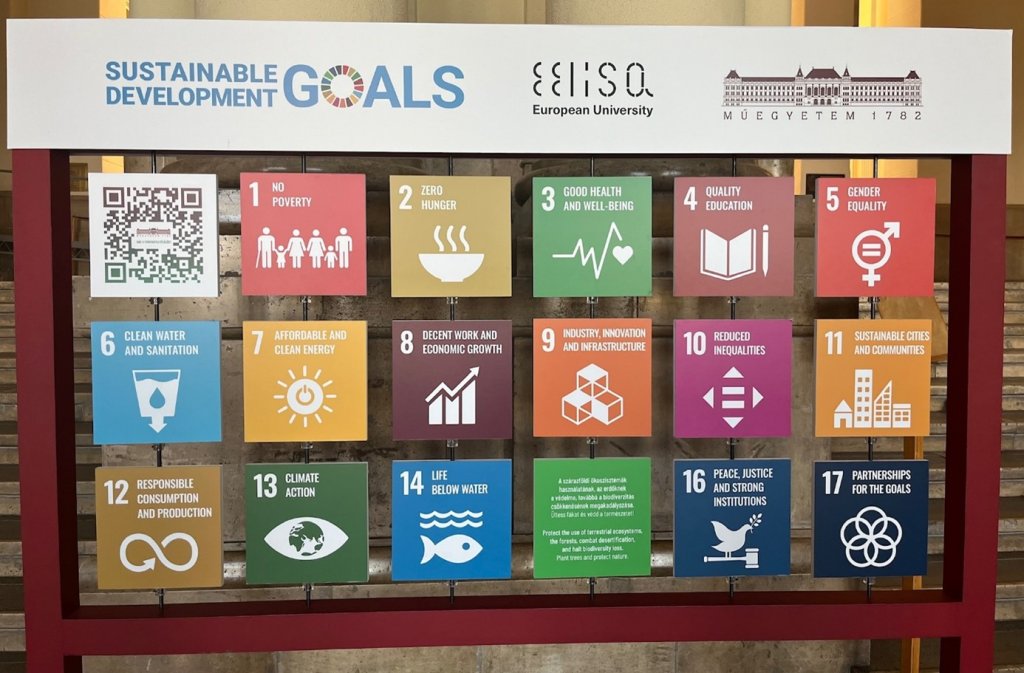News feed
17 goals for a better world – no. 15, the protection of terrestrial ecosystems
2024. 06. 24.
Our series of articles entitled “Sustainable Tuesday(s)”, will take a look over 17 weeks at the 17 Sustainable Development Goals (SDGs) set by the UN to make the world a better place.
This time, we will explore in more detail goal no. 15, the protection of terrestrial ecosystems, which is to: Protect the use of terrestrial ecosystems, the forests, and to prevent the loss of biodiversity. Plant trees and protect nature!

The focus of sustainable development goal no. 15 is the protection and sustainable use of terrestrial ecosystems, which includes a sustainable management of forests, the fight against desertification and to stop and reverse soil degradation and the loss of biodiversity.
The Gardening unit is in charge of the protection and maintenance of the green areas on the BME campus, and their activities make a large contribution to a more sustainable operation supporting biodiversity. Composting, crushing branches and spreading mulch create a cycle sustainable on the long run. Mulch is the material removed from trees and shrubs. When it’s added to flowerbeds, it supplies nutrients and preserves moisture in the soil. The versatility and diversity of perennial and annual plants are a colourful addition to the variety of the BME campus fauna (insects and birds) throughout the whole season.
It is one of the priorities of the BME Committee on Sustainability to maintain and improve biodiversity on campus. The committee initiated developing the bird-friendly garden, which made a huge progress this spring. In the first stage, nesting boxes were set up at the northern part of the campus with the help of the experts of the Hungarian Ornithological and Nature Conservation Society and with the support of the Pro Progressio Foundation, which the visitors may find in the format of a treasure hunt. These nesting boxes allow for the observation of several bird species, and together with new stages and elements of the program, such as the bee pastures and insect hotels, the diversity of the ecosystem, the number of the individuals and the biodiversity of the area may be further increased. The BME garden in the future will be integrated into various educational programs and will be open to the local communities as part of the Garden of Miracles project.
Research of soil protection and the management and improvement of polluted or otherwise degraded soils (e.g. with poor mechanical properties or extreme chemical reaction) has been going on for a long time at the BME Department of Applied Biotechnology and Food Science of the Faculty of Chemical Technology and Biotechnology. Their successful projects include remediation of the transformer-oil-polluted soil under the transformer station in Népliget or the area of the former lead and zinc mine at Gyöngyösoroszi with biotechnological procedures, or the improvement of the sandy soil in Nyírség and elsewhere with waste and soil-improvement agents (e.g. biocarbon) derived from waste. The applied technology prioritises restoration of a healthy soil ecosystem and its monitoring with soil-microbiological and environment-toxicological methods.
The quantity and quality of surface- and groundwater are largely determined by the soil conditions, land use and vegetation cover of their catchment areas. As part of the research supporting river basin management conducted at the Department of Sanitary and Environmental Engineering of the BME Faculty of Civil Engineering, the causes and process of soil erosion and the spatial pattern of soil movement are being investigated and new methods are being applied to measure their impact on water flows. The impact of land use based on restoration of natural habitats (forests, grasslands, wetlands) has been analysed as a sustainable nature-based solution in several river basins within Hungary. The project has mapped the different ecosystem services (e.g. runoff control, erosion control) provided by different vegetation types have been mapped as part of the NÖSZTÉP project. Water scarcity is the main threat for both the cultivated lands and the natural habitats of the Hungarian Great Plain. As a consequence, a new water management paradigm of the Hungarian section of the Tisza valley is under scrutiny right now, which focuses at containing inland waters, channelling flood waters into the landscape and a large-scale restoration of natural forests, grass- and wetlands.
Riverside areas play an important role in the ecosystems, which have gone through a significant degradation as a result of human intervention. When these environmental as well as social and economic issues were recognised, Danube4All has launched a multi-party international project actively involving the Department of Hydraulic and Water Resources Engineering of the BME Faculty of Civil Engineering, with the complex purpose of restoring of the Danube catchment area in mind. The integral part of the project, implemented under Horizon Europe, is to improve biodiversity and the ecological condition of the water-dependent habitats. A similarly ambitious, but nationally implemented collaborative project is the National Laboratory for Water Science and Water Safety, which is conducted with the participation of our University, with a total of 40 sub-projects under 6 pillars. One such VVNL river sub-project focuses on a multidisciplinary (cross-disciplinary) study of aquatic and water-dependent habitats, while several of the lake sub-projects examine the ecosystems of domestic lakes.
As part of the research activities of the National Programme for Sustainable Development Technologies (FFTNP), the Department of Hydraulic and Water Resources Engineering of the BME Faculty of Civil Engineering investigates the relationship between the hydrological and the atmospheric cycle and the surface cover that influences their functioning. The sustainability of terrestrial ecosystems requires a balanced functioning of the climate energy distribution system that meets climate water demand, relies on the heat transport capacity of evaporation and limits warming. A smaller part of the evaporation takes place directly from the surface, while a greater part the vegetation (transpiration, which also ensures the functioning of the "small water cycle"). Circulation and continuous replenishment of water resources, their role as energy transporters, surface cover and the water-holding capacity of the landscape are closely linked, and a better understanding of these will help both water security and the introduction of sustainable use of terrestrial ecosystems.
The Faculty of Machinery- and Product Design of the BME Faculty of Mechanical Engineering also designs agricultural machinery. Their research may contribute to a more efficient forest- and agricultural management and to a more sustainable crop cultivation as a result.
The Department of Environmental Economics and Sustainability of the BME Faculty of Economic and Social Sciences has conducted education and research of a number of subjects closely linked to the protection of terrestrial ecosystems for 35 years. These include research presenting the assessment of natural capital items and compulsory and elective subjects that explain the pecuniary value of natural resources that seem difficult to monetize at the first glance. In recent years, the department has also carried out vulnerability studies on drought and urban land-use change as one of the most important domestic sustainability challenges.
| The term SDG stands for the 17 Sustainable Development Goals established by world leaders at the 2015 UN summit to set new directions for global development. In a series of articles called “Sustainable Tuesday(s”, we will take a look at the 17 Sustainable Development Goals (SDGs) over 17 weeks and show what BME is doing to achieve them, within its own means. You can check out these development goals in a playful way with the help of boards placed at the entrances of the 3 busiest buildings (E, K, Q) on the BME campus. For more information on this topic, you can join the BME GreenHub Facebook group and visit BME’s main website to access our BME for Sustainability platform |
FV, KK (BME Committee on Sustainability)
